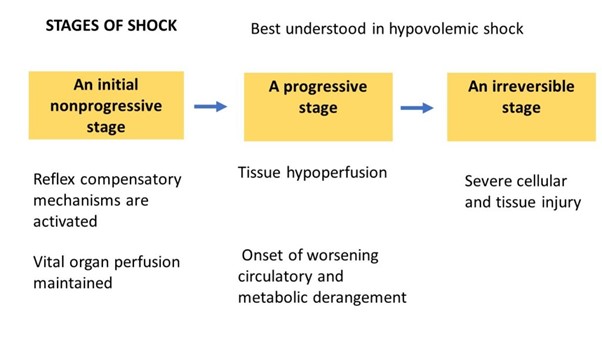A 30-year-old female patient is admitted to the emergency department with two systemic inflammatory response syndrome variables: temperature of 100.2°F (35°C) and high blood sugar. Which intervention from the sepsis resuscitation bundle does the nurse initiate?
Cooling baths
Blood transfusion
30 ml/kg of Lactated Ringers (LR)
NPO Status
The Correct Answer is C
The sepsis resuscitation bundle typically includes the administration of intravenous fluids to restore adequate perfusion and address hypovolemia. The initial fluid of choice is often the crystalloid solution, such as Lactated Ringers (LR), and the recommended initial fluid bolus is 30 ml/kg. This intervention aims to optimize intravascular volume and improve tissue perfusion.
A. Cooling baths in (option A) is incorrect because they may be used in the management of hyperthermia or fever, but they are not specific interventions in the sepsis resuscitation bundle.
B. Blood transfusion in (option B) is incorrect it may be necessary in certain cases of sepsis, such as severe anemia or hypovolemia, but it is not a routine intervention in the sepsis resuscitation bundle based solely on the provided information.
D. NPO status (nothing by mouth) in (option D) is incorrect because it is not a specific intervention in the sepsis resuscitation bundle. It may be indicated in certain cases, such as when surgery is required or if there is a risk of aspiration, but it does not directly address the sepsis-related variables mentioned.
It is important to note that the specific management of sepsis may vary based on the patient's individual condition, clinical presentation, and healthcare provider's orders.
Nursing Test Bank
Naxlex Comprehensive Predictor Exams
Related Questions
Correct Answer is A
Explanation
In the early stage of septic shock, the body initiates compensatory mechanisms to combat the infection and restore adequate tissue perfusion. Tachypnoea (rapid breathing) and tachycardia (elevated heart rate) are common early signs of septic shock.
Tachypnoea occurs as a response to increased metabolic demand and to compensate for impaired oxygenation and tissue perfusion. Tachycardia is the body's attempt to maintain cardiac output and compensate for decreased blood pressure.
B. Pallor and cool skin in (option B) is incorrect because Pallor and cool skin can occur in later stages of septic shock when perfusion to the peripheral tissues is compromised. However, they are not specific to the early stage.
C. Blood pressure 84/50 mm Hg in (option C) is incorrect because A blood pressure reading of 84/50 mm Hg indicates hypotension, which is typically seen in later stages of septic shock. In the early stage, blood pressure may still be within normal or slightly decreased range.
D. Respiratory acidosis in (optionD) is incorrect because: Respiratory acidosis refers to an imbalance in acid-base status and is not specific to the early stage of septic shock. Acid-base disturbances may occur at any stage of shock but are not indicative of the early stage.

Correct Answer is A,B,D,C
Explanation
A. Decreased blood volume: Burn injuries can lead to fluid loss, primarily through damaged skin. This fluid loss causes a decrease in blood volume, leading to hypovolemia. Hypovolemia contributes to decreased cardiac output and tissue perfusion.
B. Increased vascular permeability: Burn injuries cause an inflammatory response, leading to increased vascular permeability. This increased permeability allows fluid, electrolytes, and proteins to leak from the intravascular space into the interstitial space.
C. Development of edema: The increased vascular permeability and fluid leakage lead to the development of edema. Edema occurs as fluid accumulates in the interstitial spaces, further contributing to tissue swelling and compromised perfusion.
D. Increased peripheral resistance: In response to decreased blood volume and tissue hypoperfusion, the body activates compensatory mechanisms to maintain blood pressure and tissue perfusion. One of these mechanisms is increased peripheral resistance, which occurs as blood vessels constrict to maintain blood pressure. Increased peripheral resistance helps redirect blood flow to vital organs but also contributes to increased workload on the heart.
Therefore, the correct sequential order of events involved in burn shock following a patient's exposure to burns is:
A. Decreased blood volume B. Increased vascular permeability D. Development of edema C. Increased peripheral resistance
Whether you are a student looking to ace your exams or a practicing nurse seeking to enhance your expertise , our nursing education contents will empower you with the confidence and competence to make a difference in the lives of patients and become a respected leader in the healthcare field.
Visit Naxlex, invest in your future and unlock endless possibilities with our unparalleled nursing education contents today
Report Wrong Answer on the Current Question
Do you disagree with the answer? If yes, what is your expected answer? Explain.
Kindly be descriptive with the issue you are facing.
